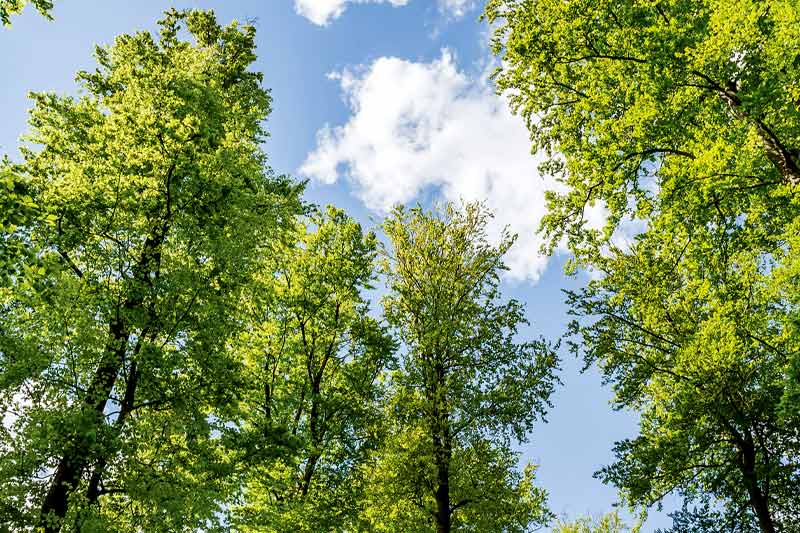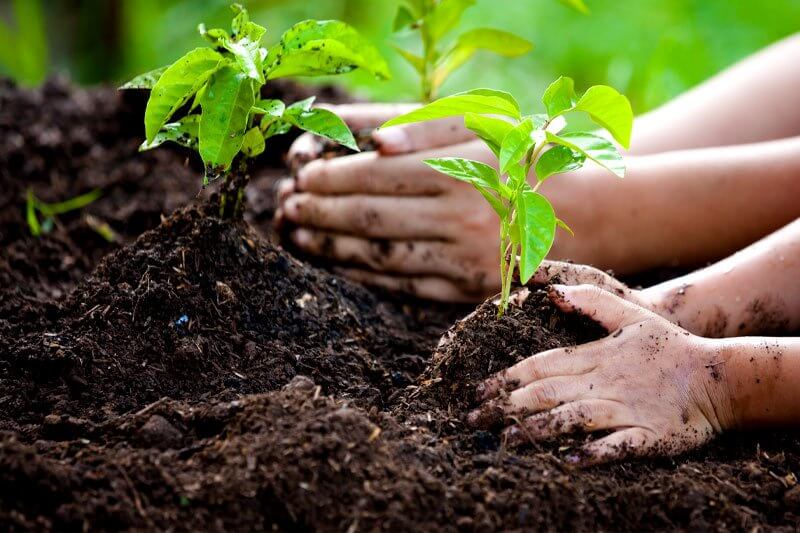Almost every effort that is aimed toward curbing climate change seems to champion the need for planting new trees. But the question is: does planting trees really help with climate change? Is it the perfect solution to global warming?
Yes, planting trees helps climate change. This is because it increases the number of trees that are pulling carbon from the air and storing it. And since an increase in carbon is one of the most notorious causes of global warming, this usually helps. However, planting trees for climate change has drawbacks.
Here is what you should know.

Trees help to slow down climate change because they use carbon dioxide as a raw material. They use it to make their own food.
In doing so, they reduce the carbon concentration in the atmosphere, offsetting the amount produced each year by humans. And since CO2 is one of the main contributors to climate change, this is something that usually goes a long way toward reducing the rate of climate change.
But trees don’t just use carbon, they store it too. They store it in their structures. And they eventually help to store it in the soil.
Both of these things have made planting trees one of the most effective ways of sequestering carbon. This makes tree planting an effective way of controlling climate change.
What are the benefits of planting trees for climate change?
While there are a lot of ways to combat climate change, planting trees for climate change has unique advantages that have made it popular.
Here are the ones that stand out.
It is measurable
The fact that you can determine how many trees you have planted, and the estimated impact of such actions, makes it easier to form plans. One can also measure the progress of such campaigns and actions. And it is thus something that a lot of people can understand and relate to.
As a result, it becomes easy for a significant portion of the populace to get behind such efforts. Receiving donations, accounting for them, and evaluating the next steps, become easier. This makes tree planting something that a vast majority of people can understand and get behind.
It is cost-effective
When compared to efforts like replacing fossil fuel use and inventing new technologies, planting trees tends to be a more cost-effective method of participating in climate change control.
It doesn’t require years of research and development to plant a seed. It also doesn’t require decades of educating people in order for them to embrace it as a way of bettering the environment. And more importantly: it doesn’t require people to change their way of life or sacrifice their livelihoods in order to be effective.
It is inclusive
Tree planting is something that everyone can take part in. It doesn’t require expertise. It also doesn’t require people to be in a given geographical location. It can be done anywhere and at any time. As a result, it is a climate change solution that is extremely inclusive. This increases the potential impact that it can have.
Furthermore, even people who can’t directly participate in the tree-planting process can be included. With many reputable organizations championing tree planting for climate change, all one has to do to take part is to donate.
It reverses the effects of deforestation
Planting trees helps to reverse the negative effects of deforestation. By doing so, it helps in:
- restoring native vegetation and animal life
- improving nature’s capacity to absorb carbon from the atmosphere
- curbing soil erosion
- improving farming opportunities
It comes with an in-built incentive
The problem with some of the solutions to climate change is that they don’t have a demonstrable impact. This makes it harder to encourage people not only to join in the efforts but also to stick with them.
Observable impact on the environment
The good thing about tree planting is that people can easily see the benefits of the activity. Within a few years, they can be able to:
- observe an improvement in the aesthetic appeal of places with planted trees
- notice an increase in populations of birds and other wildlife
- experience cleaner air and convenient shading
- observe an improvement in crop yields and a reduction in the signs of erosion
Instant effect on communities
The fact that tree planting has other benefits makes it easier to encourage communities to partake in the activity since they can enjoy direct benefits.
a. It is a suitable way of strengthening inter-community bonds
Tree planting is an engaging activity that almost anyone can participate in. Different communities in the same area often come together to plant trees because they know how beneficial the activity will be to their future.
With people from different backgrounds working towards the same goal, this is something that fosters unity and the building of the community spirit. It also promotes the exchange of ideas.
This ultimately helps to accelerate the rate at which the community makes positive strides.
b. The process improves education within communities
Tree planting days and events have played an important role in educating communities about the importance of trees. It helps people to improve their understanding of indigenous tree species.
And in most cases, it is a starting point for members of communities to advance their knowledge about their surroundings and the impact that their actions have on both their environment and the community at large.
c. It fosters a stress-free environment
Studies have routinely shown that spending time in green spaces helps with stress relief.
Tree planting fosters mental health by creating more green environments in a given community. This is so especially given that it also encourages members to spend time outside and engage in outside activities.
d. It cleans the air
Trees absorb air pollutants. They trap dust. And they also release oxygen into the environment.
All of these things improve air quality. This improves the overall health and well-being of community members.
e. It has economic benefits
Tree planting improves the aesthetic appeal of the area in which they are planted. This aesthetic value tends to translate into the housing market where it raises the prices of homes in the area.
- Trees can also improve crop yields, especially when done through agroforestry.
- The process of establishing new trees can also offer direct employment to members of the community.
- Some trees produce edible fruits. These can be a source of food for community members. The members can also sell them at a profit.
- Some indigenous tree species have medicinal properties. Such trees can help to save on medical bills. They can also be used as raw materials for medicine production.
- Communities that live in hot areas can also end up saving on cooling costs. This is because trees provide shade. The cooling effect of the shading helps to make it easier for homes to maintain comfortable temperatures.
All these benefits make it easier for communities to get behind tree-planting efforts. This alone goes a long way towards increasing its effectiveness as a climate change solution.
What are the disadvantages of planting trees for climate change?
While tree planting has been widely hailed as the go-to solution for climate change, it is not perfect. In fact, in some cases, it can have negative consequences on both the environment and climate change.

Here are the disadvantages of relying on planting trees as a way of solving climate change.
1. It is a temporary fix
Trees help with climate change by siphoning carbon from the air. The problem is that they can only store this carbon for as long as they are growing. If they die, or if they get cut down, they release the carbon back into the atmosphere.
The fact that trees don’t form permanent carbon stores makes them a temporary solution to the climate change problem. As a result, it is not an ideal solution especially if the goal is to ensure that future generations are safe from the negative effects of climate change.
2. It is not as effective
It is true that trees are effective at pulling carbon from the air. However, given the rate at which carbon is released into the atmosphere, it is not enough.
Trees don’t absorb as much carbon as would be needed to prevent climate change. They also don’t grow fast enough. Therefore, given the current levels of carbon emissions, no amount of tree planting can make up for it.
3. The process isn't eco-friendly
Heavy machinery is usually used during the tree-planting process. These machines use fuel derived from fossil fuels. They often end up polluting the environment.
Plastics also play a significant role in the process. They are used to store seedlings. They are used to support growing trees. And they are often used to shield the trees from damage.
Therefore, while planting trees has some advantages, it isn’t the most eco-friendly method of preventing climate change.
4. It is detrimental to biodiversity
Most tree-planting programs are focused on establishing as many trees as possible. This often leads to the planting of tree species that grow fast like eucalyptus and acacia.
The problem is that this approach to climate change control is detrimental to biodiversity. Commercial and fast-growing trees are often planted at the expense of indigenous tree species.
5. Trees can trap heat
Trees are darker than snow, rocks, or any of the things that may be already blanketing the land. When you plant them in these areas, you create a darker cover that is more likely to absorb and trap heat.
As a result, planting trees can actually end up warming the areas in which they are planted. This means that as a solution against climate change, it can actually have the opposite of the desired effect.
6. It serves as a distraction
Reducing the level of carbon emissions is a way more effective method of climate change control. However, tree planting has often taken center stage as far as climate control solutions are concerned.
Focusing on tree planting as the ideal climate solution often overshadows other approaches that have been proven to be way more effective. As a result, tree-planting campaigns can sometimes serve as detrimental distractions.
7. Trees encourage methane gas formation
Trees release aerosols. These compounds encourage the formation of ozone, and in so doing, create a layer that encourages global warming. What this means is that planting trees isn’t really a surefire way of resolving the climate change problem simply because they have a complicated relationship.
While trees serve an important role when it comes to fighting climate change, planting new trees has its shortcomings. Therefore, instead of planting new trees, the focus should be on protecting existing ones. Doing so does away with most of the negative effects that tree planting has.
By preventing deforestation, you won’t have to worry about:
- Using machinery and materials that are not eco-friendly
- Replacing indigenous species
- Accidentally encouraging warming by darkening parts of the planet
- Increasing competition for space with urban populations and farmers
- Reduced freshwater availability and river discharge
Use this free service to find a tree expert near you
If you need help trimming or removing trees, GoTreeQuotes.com offers a free service that quickly matches you with the top-voted local experts in your area.
You can get 3 estimates fast by real certified tree experts in your area in just 2 minutes. Here is how it works.
- You scroll to the top of the page and enter your Zip code.
- Answer questions about your tree care needs
- Your details will be forwarded to three local experts.
- You will then receive a price estimate for the job and some friendly advice.
IMPORTANT: There is no obligation to hire. This is a free tool and service to be used at your pleasure.




